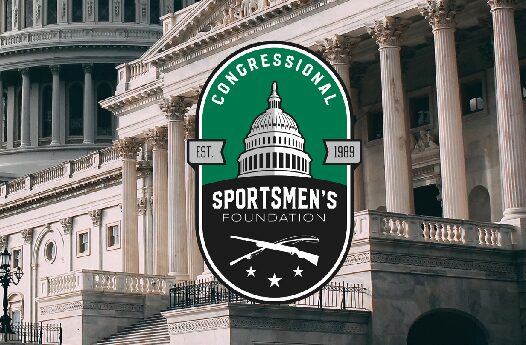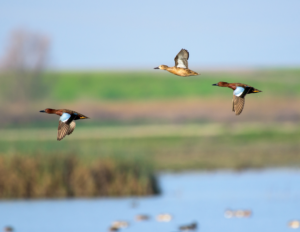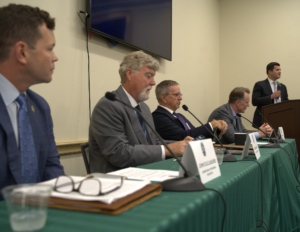Policy Corner Brief: AUGUST 2024

HOUSE NATURAL RESOURCES SUBCOMMITTEE HEARS IMPORTANT CSF PRIORITY
ARTICLE CONTACT: TAYLOR SCHMITZ
Why it Matters: The America’s Conservation Enhancement Reauthorization Act (ACE) reauthorizes nearly a dozen provisions that will bolster the conservation of fish, wildlife, and their associated habitats across North America and provides an important protection for America’s anglers. The ACE Act has been a long-standing priority for the Congressional Sportsmen’s Foundation (CSF) since first enacted with CSF’s support in 2020.
Highlights:
- Recently, the House Natural Resources Committee on Water, Wildlife and Fisheries held a legislative hearing to consider a number of bills, including a top CSF priority known as the America’s Conservation Enhancement Reauthorization Act (H.R. 8811).
- This bipartisan legislation is led in the House by Congressional Sportsmen’s Caucus (CSC) Members Rep. Wittman, Dingell, Kiggans, and M. Thompson.
- The Senate bill is also led in a bipartisan fashion by CSC Member and Chair of the Senate Environment and Public Works (EPW) Committee Sen. Carper, EPW Ranking Member and CSC Member Sen. Capito, who are joined by CSC Co-Chair Sen. Boozman, CSC Members Senators Mullin and Wicker, among other bipartisan cosponsors.
The ACE Reauthorization Act is an important piece of legislation that reauthorizes critical fish, wildlife, and habitat conservation programs across the nation for a period of five years. Specifically, these programs include the North American Wetlands Conservation Act (NAWCA), the National Fish Habitat Conservation Through Partnerships (NFHP), among other funding programs, as well as an important protection for recreational anglers.
NAWCA provides strategic investments to conserving and restoring degraded wetlands across North America. Since its inception 35 years ago, NAWCA has provided over $2.1 billion in federal grants that has leveraged nearly $4.3 billion in non-federal contributions. In total, there have been over 3,300 NAWCA projects that have contributed to the conservation of nearly 32 million acres of wetlands in the United States, Mexico, and Canada.
Additionally, this legislation reauthorizes the National Fish Habitat Conservation Through Partnerships. NFHP is a state and locally driven program that leverages partners to conserve priority aquatic habitat needs, restore fish populations, and enhance recreational fishing opportunities. CSF’s Senior Director, Fisheries Policy, Chris Horton was recently reappointed to serve on the NFHP Board.
The ACE Act also includes an important protection to prohibit the Environmental Protection Agency (EPA) from regulating the use of lead fishing tackle under the purview of the Toxic Substances Control Act (TSCA). The EPA has consistently reaffirmed state management authority of lead fishing tackle and this legislation will ensure the EPA cannot be petitioned to regulate lead tackle under TSCA for a period of 5 years.
CSF thanks the House leaders of this legislation as well as the Natural Resource Committee for hearing and discussing this important bill. CSF will continue to work to see this legislation get across the finish line in 2024.
HOME ON THE RANGE: RECREATIONAL SHOOTING IS AN UNSUNG HERO OF OUR SPORTING TRADITIONS
ARTICLE CONTACT: BOB MATTHEWS
Why It Matters: Through the unique “user pays – public benefits” structure of the American System of Conservation Funding (ASCF), recreational shooters are an unsung hero of conservation funding. Manufacturers of firearms and ammunition supported the passage of Federal Aid in Wildlife Restoration Act, redirecting an existing manufacturer-level excise tax on their products to be designated specifically for conservation purposes, which is then apportioned to the States in order to carry out conservation efforts.
Highlights:
- The Indiana Department of Natural Resources (DNR) recently announced that it is accepting applications for grants to support the development of shooting ranges in the Hoosier State.
- Recreational shooting is a silver bullet (pun intended) for conservation funding in America, with more than 52 million Americans spending nearly $17 billion on the sport each year.
- In addition to allowing shooters the opportunity to hone their craft and sight-in firearms, which in-turn creates more ethical and successful hunters, shooting ranges provide a safe environment for newcomers to become comfortable with firearms and join us in our time-honored outdoor traditions.
- Recognizing their positive financial and participation impacts, the Congressional Sportsmen’s Foundation (CSF) has long advocated for increased opportunity for recreational shooters, and new or improved ranges like those supported by Indiana’s grant program are a great example of how that can be achieved.
With the Indiana DNR’s recent call for grant applications to support the development of shooting ranges in the Hoosier State, sportsmen and women should be reminded of the importance that such ranges have on conservation. Thanks to the Federal Wildlife Aid in Wildlife Restoration Act, commonly known as the “Pittman-Robertson Act,” as well as the Federal Aid in Sport Fish Restoration Act, or the “Dingell-Johnson Act,” manufacturers of outdoor sporting goods have paid an excise tax on their products, including firearms, ammunition, fishing rods, bait and tackle, and more to support conservation efforts. This is one of three prongs of the American System of Conservation Funding, with the other two being the sale of both hunting and fishing licenses.
Through this unique structure, hunters, anglers, recreational shooters, and trappers pay for their licenses and equipment, but the entire public benefits from the results of that revenue. Under Pittman-Robertson and Dingell-Johnson as amended, the funds are authorized to be used by state fish and wildlife agencies to conduct research, acquire new public lands, manage habitat on both public and private lands, construct and maintain boat launches, and more. State agencies may also use those funds to develop shooting ranges – which is where the grant money offered by the Indiana DNR comes from.
Recreational shooting and hunting have a combined economic output of $149 billion and support 970,000 jobs each year. On top of providing opportunity to the existing pool of sportsmen and women that feel at home on the range, shooting ranges offer a controlled, safe environment for newcomers or lapsed shooters to become comfortable with their firearms, oftentimes resulting in their confidence to take an ethical shot while afield. With more ranges comes more opportunity for those newcomers to join us outdoors and continue generating the funds that our state fish and wildlife agencies desperately need to carry out their conservation duties, ensuring the protection of our outdoor pursuits for generations to come.
CONGRESSIONAL SPORTSMEN’S FOUNDATION HOSTS BREAKFAST BRIEFING ON SUSTAINABLE FOREST MANAGEMENT, LAUNCHES NEW PROGRAMMATIC EMPHASIS ON FOREST POLICY
August 5, 2024 (Washington, DC) – Last week, more than 50 congressional staff, leaders of forest policy, state foresters, and key partners attended the Congressional Sportsmen’s Foundation’s (CSF) Sustainable Forest Management Policy Briefing that highlighted forest policies and programs impacting wildlife and hunter access on private working forests and federal forests. At the briefing CSF announced its expanded emphasis on forest policy through the creation of a full-time Director of Forest Policy position.
Active forest management is critical for creating quality wildlife habitat, improving forest health and resiliency, mitigating risk to catastrophic wildfire, increasing forest carbon sequestration and carbon storage capabilities, and increasing access for sportsmen and women. CSF regularly engages on forest policy, and through the creation of the new forest policy specific position, CSF will significantly increase its work on forest management issues that impact sportsmen and women at the state and federal levels on private and public lands. John Culclasure, formerly CSF’s Southeastern States Director and a trained forester, stepped into the new Director of Forest Policy position after spending 8 years on CSF’s States Program Team.
“The Congressional Sportsmen’s Foundation has long recognized the importance of sustainable forest management to wildlife management and increasing access and opportunity for sportsmen and women,” said CSF President and CEO Jeff Crane. “We value our partnerships with the forestry community and look forward to amplifying the sportsmen’s voice on forestry issues through the launch of our dedicated Forest Policy Portfolio headed up by John Culclasure.”
The briefing consisted of a panel of experts representing the forest industry and the sportsmen’s community who discussed various forest policy issues ranging from collaborative wildlife conservation initiatives on private lands to wildfire risk reduction projects on federal public lands. The panel included Brian Luoma, retired President and CEO, The Westervelt Company; Bill Imbergamo, Executive Director Federal Forest Resource Coalition (FFRC); David Tenny, President and CEO, National Alliance of Forest Owners (NAFO); and John Culclasure, Director of Forest Policy, Congressional Sportsmen’s Foundation.
Panelists at the briefing provided their perspectives on how sound forest management policy supports wildlife conservation for game and nongame species and the importance of collaborating with federal land managers to mitigate wildfire risk for the benefit of private and public forests, wildlife, and hunters and anglers. CSF is working with NAFO and other conservation partners to support the creation of the Forest Conservation Easement Program to keep working forests working, and CSF supports the Fix Our Forests Act alongside FFRC which contains several longstanding forest management priorities for the sportsmen’s community, including litigation reform and a Cottonwood fix.
The Sustainable Forest Management Policy Briefing was a success and served as an excellent launch point for CSF’s expanded emphasis on forest policy. As the backbone for conservation funding in the nation, America’s 55 million sportsmen and women have earned a seat at the table, and CSF will work to ensure that the sporting-conservation community is given a voice in forest management and beyond. For more information on active forest management, click here.
Sustainable Forest Management Policy Briefing Panelists (from left to right): John Culclasure, Director of Forest Policy, Congressional Sportsmen’s Foundation; Brian Luoma, retired President and CEO, The Westervelt Company; Bill Imbergamo, Executive Director, Federal Forest Resource Coalition; and David Tenny, President and CEO, National Alliance of Forest Owners
TAKING A CLOSER LOOK AT REIMBURSEMENT TO FISH AND WILDLIFE AGENCIES FOR FREE AND DISCOUNTED LICENSES
ARTICLE CONTACT: KALEIGH LEAGER
Why It Matters: Each year, legislators look at ways to recognize and thank certain qualified individuals/groups by providing free and/or discounted licenses for hunting, fishing, and trapping. While this is well-intended, such legislation has the potential to reap deteriorative effects on the fish and wildlife agencies’ budgets. To prevent the loss of sportsmen-generate dollars for conservation funding, The Congressional Sportsmen’s Foundation (CSF) has prioritized encouraging states to introduce legislation that would require reimbursement to the state fish and wildlife agencies from the general funds for any free and discounted licenses.
Highlights:
- State fish and wildlife agencies are primarily funded through the American System of Conservation Funding (ASCF).
- 49 states currently offer reduced fees for senior hunters and anglers, while only 4 have implemented legislation to reimburse their fish and wildlife agencies for the loss in revenue.
- States continue to introduce legislation that provides free and discounted hunting and fishing licenses for groups and individuals such as first responders, active military personnel, and the disabled.
- States must receive a net revenue of $2.00 from each license sale to report a certified license holder which qualifies for additional federal funds. Virginia reported that each certified hunting license brings the state an additional $26, and each fishing license brings in $10 of federal aid. When license fees are eliminated completely, states lose out on this additional revenue in addition to the loss of the original cost of the license.
On average, 60% of the funds that make up a states fish and wildlife agency derive from sportsmen and women generated dollars through the ASCF. This system is a “user pays – public benefits” funding mechanism that goes towards conserving habitat, managing wildlife and fish, and providing access to state owned public lands that are used for hunting, fishing, biking, hiking, horseback riding, birding, kayaking, etc. Most recently, after strong support spearheaded by CSF alongside the Louisiana Legislative Sportsmen’s Caucus (Caucus) and the Louisiana Department of Wildlife and Fisheries, Louisiana adopted HB 795, which was championed by NASC Executive Council Member and Caucus Co-Chair Representative Jerome Zeringue. HB 795 mirrored Tennessee’s successful reimbursement model. CSF applauds the 4 states (LA, MI, NJ, TN) that have mechanisms in place that reimburses their state fish and wildlife agencies for the cost of list license sale revenue. CSF looks forward to working with the MA Legislative Sportsmen’s Caucus to advancing MA S. 499 – An Act to reimburse the George L. Darey Inland Fisheries and Game Fund, across the finish line. MA has been involved in a multi-year effort to bring this CSF top priority to life in the Bay State.
Moving forward, CSF encourages legislators to introduce legislation like the abovementioned states to protect the state agency’s ability to carry out their mission. Revenue from hunting and fishing license sales is one of the major funding sources for the agencies that work to ensure the health of our fish and wildlife populations and their habitats. When giving out free and discounted licenses states limit the ability of the fish and wildlife agencies to fund their conservation work, which benefits all citizens.
States Involved: LA / MA / MI / NJ / TN
FWS RELEASES 2024 – 2025 HUNT FISH RULE – ANOTHER MIXED BAG FOR SPORTSMEN AND WOMEN
ARTICLE CONTACT: TAYLOR SCHMITZ
Why It Matters: The U.S. Fish and Wildlife Service (FWS) provides significant access opportunities for sportsmen and women, primarily through the National Wildlife Refuge System (NWRS), which supports more than 2.4 million hunting related visits and 7.3 million fishing visits annually. Access to NWRS managed lands and waters for hunting and fishing is critical for our outdoor traditions; however, access is defined by more than acres and lands that are open to hunting. Access also includes allowances for methods of take, as is the case with this proposal rule.
Highlights:
- Last week, the U.S. Fish and Wildlife Service announced the proposed 2024 – 2025 Hunt Fish Rule, which is an annual effort that is intended to increase opportunities for sportsmen and women, and to align state and federal hunting and fishing regulations within the National Wildlife Refuge System.
- The proposed Hunt Fish Rule is a mixed bag for sportsmen and women as it seeks to expand access across 211,000 acres covering 12 different NWRS units and encompasses 53 distinct hunting and fishing opportunities. Unfortunately, the proposal also seeks to prohibit the use of traditional ammunition and tackle for newly expanded opportunities.
- While the Congressional Sportsmen’s Foundation (CSF) strongly supports and appreciates the efforts by FWS to expand hunting and fishing opportunities, we are concerned that this proposal arbitrarily limits the use of traditional ammunition and tackle for new opportunities, which in turn can make access more challenging for sportsmen and women.
On Thursday, August 1, the U.S. Fish and Wildlife announced the 2024 – 2025 Hunt Fish Rule, which includes victories for sportsmen and women as well as some concerning constraints.
On one hand, the Hunt Fish Rule is a step in the right direction for sportsmen and women with the expansion of hunting and fishing opportunities across 211,000 acres. At a time when access is becoming more challenging for hunting and fishing, we are pleased to see federal agencies making strides to improve and expand hunting opportunities within our federal public lands.
On the other hand, CSF is concerned to see that the use of lead ammunition is arbitrarily restricted for use in the newly expanded opportunities. This action is certainly not aligned with state fishing and hunting regulations or the preferred approach of state fish and wildlife agencies through educational efforts and voluntary, incentive-based programming rather than outright bans. With this, the U.S. Fish and Wildlife Service is creating confusion for sportsmen and women, law enforcement, and others by overlapping non-lead hunting opportunities with hunting opportunities where hunters can make their own determination as to what type of ammunition they prefer while afield. For instance, sportsmen and women can use traditional ammunition on one side of the fence but crossing over into one of the newly opened areas of a refuge unit they are restricted from using lead ammunition. Furthermore, the proposal also does not appear to follow any scientific justification for what seems to be a random consortium of refuge units.
Additionally, the restriction of lead ammunition for newly expanded opportunities in the proposal appears to run counter to the voluntary, non-prohibitive, non-lead pilot projects announced by FWS less than two weeks ago. These pilot projects seek to allow hunters to make their own determination as to what type of ammunition they prefer while afield rather than arbitrary restrictions on the use of this highly popular method of take. CSF maintains that restrictions on the use of lead ammunition and tackle should follow a science driven process, which does not appear to be the case for this proposed Hunt Fish Rule.
The Congressional Sportsmen’s Foundation will continue to advocate for increased access for sportsmen and women and will continue to defend arbitrary limitations on the use of highly popular methods of take such as traditional ammunition and tackle.
EXCISE TAX ON AMMUNITION INTRODUCED DURING SPECIAL SESSION IN THE CORNHUSKER STATE
ARTICLE CONTACT: JAKE GOULD
Why it Matters: Excise taxes imposed on firearms and ammunition at the state level place an overly burdensome expenditure on the backs of sportsmen and women. Firearms and ammunition are already subject to federal excise taxes at the manufacturer-level through the widely celebrated Pittman-Robertson Act which funds a variety of hunting, shooting, and wildlife conservation-related activities. Imposing a state-level excise tax could carry negative impacts on participation in hunting and recreational shooting in the Cornhusker State.
Highlights:
- Introduced during a special session called for by Governors Sportsmen’s Caucus Member Governor Jim Pillen to evaluate tax priorities, Nebraska Legislative Bill 65 (LB 65) would impose a 5% excise tax on all ammunition sales in the state.
- Though unlikely to pass during the special session following its recent hearing, LB 65 joins several other bills from across the country in a growing trend of increasing taxes on firearms and ammunition.
- The Congressional Sportsmen’s Foundation (CSF) will continue to oppose legislation, like LB 65, that imposes these state-level excise taxes on firearms and ammunition.
Nebraska started their special session on July 25 with the legislative focus being placed on taxation. Introduced during the special session was Legislative Bill 65, which would impose a new 5% excise tax on all ammunition sales in the state. The Congressional Sportsmen’s Foundation has been active in alerting in-state partners about the negative impacts that a state-level imposed excise tax would have on recreational shooters and sportsmen and women.
LB 65, if passed, would impose a 5% excise tax on all ammunition sales in Nebraska, and divert 50% of the proceeds to the Property Tax Credit Fund, 35% to the Wildlife Management fund, and the remaining to the Post-Traumatic Stress Disorder Grant Program Fund. This effort, and others like it, are different than existing federal laws like the widely celebrated Pittman-Robertson Act through which firearms and ammunition are federally taxed at the manufacturer-level. The federal excise tax serves as a primary part of the “user pays – public benefits” American System of Conservation Funding (ASCF), which is used for the funding of wildlife research, private and public land habitat management, hunter education, shooting range development, land acquisition, and hunting access, all at the state level.
Imposing a 5% state excise tax on ammunition could have negative impacts on conservation funding, participation in hunting and recreational shooting, and the Nebraska Game and Parks Commission’s (NGPC) ability to manage wildlife that benefits all Nebraskans. In 2023, Nebraska received over $19 million in federal funding for wildlife restoration and hunter education programs. NGPC relies on the ASCF to carry out their conservation efforts in Nebraska. By burdening sportsmen and women with even more costs, LB 65, if passed, could result in a reduction of ammunition sales and overall demand for ammunition, which could ultimately decrease the amount of conservation dollars the NGPC and all other state fish and wildlife agencies would receive through the Pittman-Robertson Act.
While the bill is not expected to receive additional attention during this special session, CSF remains prepared to engage and protect our sporting-conservation community against efforts such as this.
States Involved: NE
SHARE ON
You may also like
The role corn plays for gamebirds and economies ac...
Sportsmen’s conservation policy issues from publ...
Sportsmen’s conservation policy issues from publ...





























